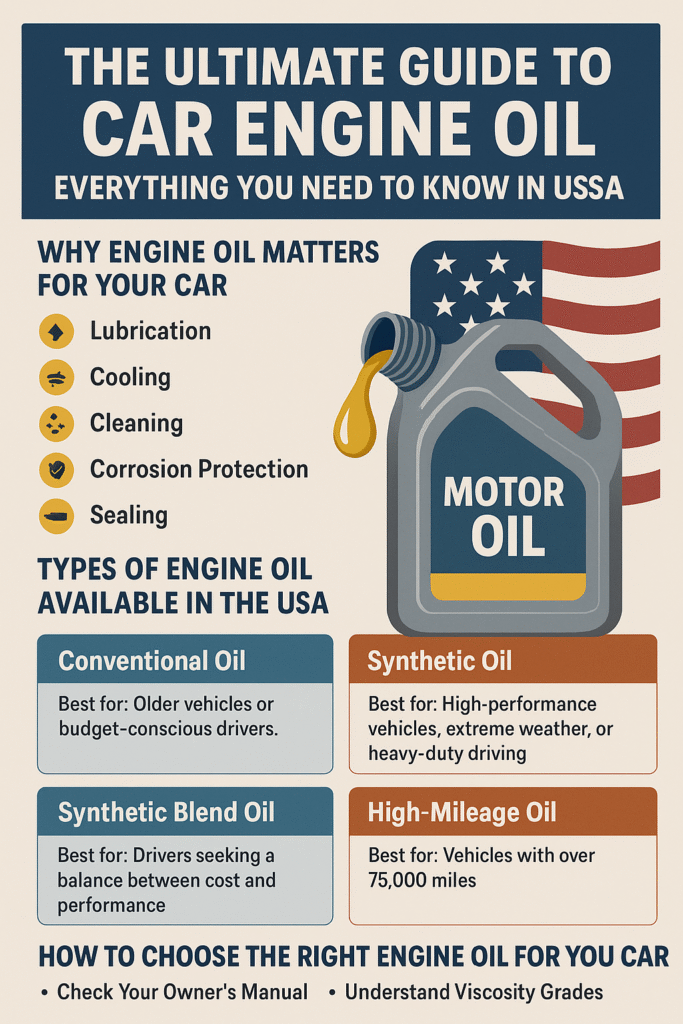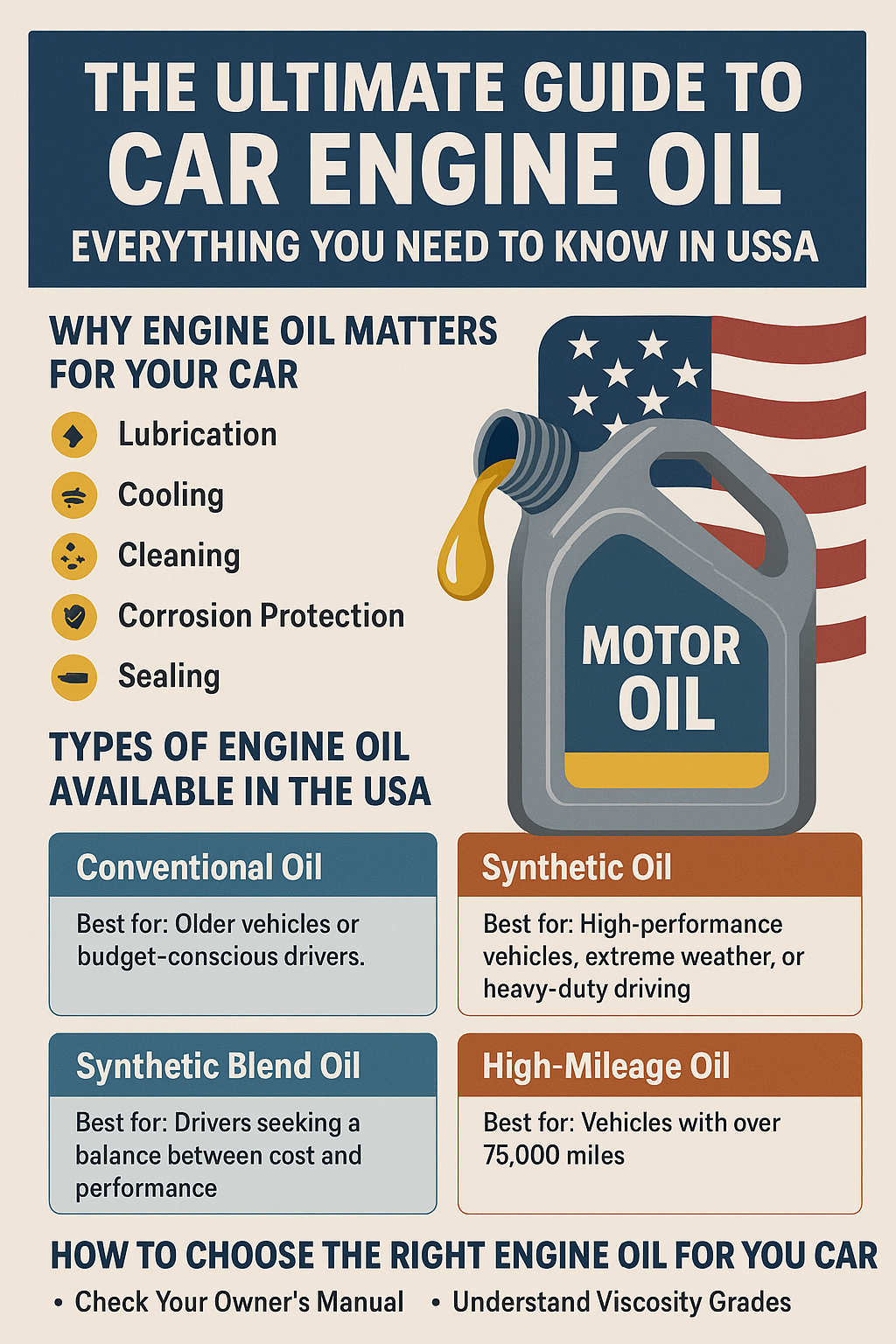
Car engine oil is the lifeblood of your vehicle, ensuring smooth performance, longevity, and efficiency. Whether you’re a car enthusiast or a daily commuter in the USA, understanding engine oil is crucial for maintaining your vehicle’s health. This guide covers everything from choosing the right oil to maintenance tips, optimized for drivers across the United States.
Why Engine Oil Matters for Your Car
Engine oil lubricates moving parts, reduces friction, prevents overheating, and protects against wear and tear. In the USA, where road trips and long commutes are common, using the right engine oil can improve fuel efficiency and extend engine life. According to the American Automobile Association (AAA), regular oil changes can prevent up to 70% of engine-related issues.
Key Functions of Engine Oil
- Lubrication: Reduces friction between engine components.
- Cooling: Dissipates heat from critical engine parts.
- Cleaning: Traps dirt and debris to keep the engine clean.
- Corrosion Protection: Prevents rust and corrosion.
- Sealing: Enhances the seal between pistons and cylinders for optimal performance.
Types of Engine Oil Available in the USA
Choosing the right engine oil can be overwhelming with so many options. Here’s a breakdown of the main types available in the USA:
1. Conventional Oil
- Best for: Older vehicles or budget-conscious drivers.
- Pros: Affordable, widely available at retailers like Walmart and AutoZone.
- Cons: Shorter lifespan, less effective in extreme temperatures.
- Popular Brands: Pennzoil Conventional, Valvoline Daily Protection.
2. Synthetic Oil
- Best for: High-performance vehicles, extreme weather, or heavy-duty driving.
- Pros: Longer-lasting, better performance in hot and cold climates, improved fuel economy.
- Cons: More expensive.
- Popular Brands: Mobil 1, Castrol EDGE, Royal Purple.
3. Synthetic Blend Oil
- Best for: Drivers seeking a balance between cost and performance.
- Pros: Offers some benefits of synthetic oil at a lower price.
- Cons: Not as durable as full synthetic.
- Popular Brands: Valvoline Synthetic Blend, Quaker State Advanced Durability.
4. High-Mileage Oil
- Best for: Vehicles with over 75,000 miles.
- Pros: Contains additives to reduce leaks and oil burn-off in older engines.
- Cons: Slightly more expensive than conventional oil.
- Popular Brands: Castrol GTX High Mileage, Pennzoil High Mileage.
How to Choose the Right Engine Oil for Your Car
Selecting the best engine oil depends on your vehicle, driving habits, and the USA’s diverse climates. Here are key factors to consider:
1. Check Your Owner’s Manual
Your car’s manufacturer specifies the recommended oil viscosity (e.g., 5W-30, 0W-20) and type. For example, many modern vehicles, like those from Ford or Toyota, require synthetic 5W-20 or 0W-20 for optimal performance.
2. Understand Viscosity Grades
Viscosity, indicated by numbers like 5W-30, determines how oil flows in different temperatures:
- First number (e.g., 5W): Indicates cold-weather performance (lower is better for colder states like Minnesota).
- Second number (e.g., 30): Indicates performance at operating temperatures.
- For hot climates like Arizona, a higher second number (e.g., 10W-40) may be ideal.
3. Consider Driving Conditions
- City Driving: Frequent stop-and-go traffic in cities like Los Angeles or New York requires synthetic oils for better protection.
- Highway Driving: Conventional or synthetic blends may suffice for long, steady drives.
- Extreme Weather: Synthetic oils perform better in extreme heat or cold, common in states like Texas or Alaska.
4. API and ILSAC Certifications
Look for oils with certifications like API SN or ILSAC GF-6, which meet modern engine standards. These are widely available at retailers like Advance Auto Parts or O’Reilly Auto Parts.
How Often Should You Change Your Engine Oil?
Oil change intervals vary based on oil type, vehicle, and driving habits:
- Conventional Oil: Every 3,000–5,000 miles or 3–6 months.
- Synthetic Blend: Every 5,000–7,500 miles.
- Full Synthetic: Every 7,500–15,000 miles, depending on the brand and driving conditions.
For example, a 2023 Honda Civic in urban Chicago traffic may need oil changes every 5,000 miles, while a Toyota Camry on California highways using synthetic oil could go 10,000 miles. Always follow your manufacturer’s recommendations.
Top Engine Oil Brands in the USA
Here are some trusted brands available at major retailers like Amazon, AutoZone, or Pep Boys:
- Mobil 1: Known for superior synthetic oils, ideal for performance vehicles.
- Castrol: Offers a range of conventional, synthetic, and high-mileage oils.
- Valvoline: Popular for its synthetic blends and high-mileage formulas.
- Pennzoil: Provides affordable conventional and high-performance synthetic oils.
- Royal Purple: Premium synthetic oil for enthusiasts seeking maximum engine protection.
DIY vs. Professional Oil Changes
DIY Oil Changes
- Pros: Cost-effective (average cost: $20–$50 for oil and filter).
- Cons: Requires tools, time, and proper disposal of used oil.
- Tips: Use a quality oil filter (e.g., FRAM, Bosch) and recycle used oil at local centers like those listed by the EPA.
Professional Oil Changes
- Pros: Convenient, often includes multi-point inspections.
- Cons: More expensive (average cost: $35–$100 at shops like Jiffy Lube or Midas).
- Tips: Look for deals at national chains or local mechanics in your area.
Environmental Impact and Recycling in the USA
Used engine oil is hazardous if not disposed of properly. In the USA, you can recycle oil at:
- Auto parts stores like AutoZone or Advance Auto Parts.
- Local recycling centers (check Earth911.com for locations).
- Service stations offering oil change services.
According to the EPA, recycling one gallon of used oil can generate enough energy to power a household for nearly 24 hours.
Common Engine Oil Myths Debunked
- Myth: All oils are the same.
- Fact: Oils vary in additives, viscosity, and performance. Always choose based on your vehicle’s needs.
- Myth: You must change oil every 3,000 miles.
- Fact: Modern synthetic oils can last up to 15,000 miles in some cases.
- Myth: Dark oil always needs changing.
- Fact: Dark oil is normal as it traps dirt; follow your vehicle’s maintenance schedule.
Conclusion
Choosing the right engine oil and maintaining a regular oil change schedule are vital for keeping your car running smoothly in the USA. Whether you’re navigating icy roads in Michigan or cruising through Florida’s heat, the right oil can make all the difference. Consult your owner’s manual, consider your driving conditions, and opt for trusted brands to ensure your engine’s longevity.
For more tips on car maintenance or to find the best engine oil deals, visit retailers like Amazon, AutoZone, or Walmart, or check with your local mechanic. Keep your engine happy, and it’ll keep you on the road!
Disclaimer: Always consult your vehicle’s manual and a professional mechanic for specific advice tailored to your car.
Recent Posts
Cold-Weather Driving Essentials: Top Gloves for Safe Winter Travel
Keep your hands warm and your steering wheel secure this winter with our top glove picks. Discover the best options for safe and comfortable cold-weather driving!
Tesla Roof Rack Storage: Ultimate Guide to Secure and Versatile Cargo Solutions
Tesla roof rack storage offers extra space to carry luggage and gear securely on your Model Y. These racks fit various needs, from bikes to kayaks, making travel easier. ...


